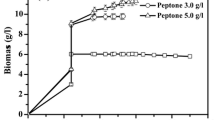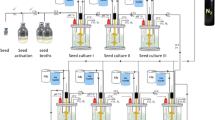Abstract
Substrate concentration in 2,3-butanediol (2,3-BD) fermentation could not be controlled well in traditional feeding strategies, such as constant, impulse, and exponential feeding strategies. In the present study, fermentative 2,3-BD production by Klebsiella oxytoca was investigated under different batch and fed-batch strategies. The glucose-feedback fed-batch strategy was proved to be not effective for economical 2,3-BD production for the inability of timely feeding, leading that the bacteria reused 2,3-BD as carbon source for cell growth. Based on the phenomena that the byproducing acids caused the pH declining and the requirement of maintaining the pH at a proper level for both cell growth and 2,3-BD accumulation, an improved strategy of pH-stat fed-batch culture with glucose and sodium hydrate fed at the same time was established. Thus, the residual glucose concentration could be controlled through the adjustment of pH automatically. At last, efficient 2,3-BD production was fulfilled under this fed-batch strategy, and the highest 2,3-BD concentration, productivity, and yield were 127.9 g/l, 1.78 g/(l•h), and 0.48 g/g (2,3-BD/glucose), respectively, compared to 98.5 g/l, 1.37 g/(l•h), and 0.43 g/g obtained in glucose-feedback fed-batch strategy. This feeding strategy was simple and easy to operate and could be feasible for industrial 2,3-BD production in the future.




Similar content being viewed by others
References
Ragauskas, A. J., Williams, C. K., Davison, B. H., Britovsek, G., Cairney, J., Eckert, C. A., et al. (2006). Science, 311, 484–498.
Li, Z. J., Ji, X. J., Kan, S. L., Qiao, H. Q., Jiang, M., Lu, D. Q., et al. (2010). Advances in Biochemical Engineering/Biotechnology, 122, 1–42.
Tran, A. V., & Chambers, R. P. (1987). Biotechnology and Bioengineering, 29, 343–351.
van Haveren, J., Scott, E. L., & Sanders, J. (2007). Biofuels, Bioproducts and Biorefining, 2, 41–57.
Celińska, E., & Grajek, W. (2009). Biotechnology Advances, 27, 715–725.
Ji, X. J., Huang, H., Du, J., Zhu, J. G., Ren, L. J., Li, S., et al. (2009). Bioresource Technology, 100, 5214–5218.
Ji, X. J., Huang, H., Zhu, J. G., Ren, L. J., Nie, Z. K., Du, J., et al. (2010). Applied Microbiology and Biotechnology, 85, 1751–1758.
Syu, M. J. (2001). Applied Microbiology and Biotechnology, 55, 10–18.
Kosaric, N., Magee, R. J., & Blaszczyk, R. (1992). Chemical and Biochemical Engineering Quarterly, 6, 145–152.
Wu, K. J., Saratale, G. D., Lo, Y. C., Chen, W. M., Tseng, Z. J., Chang, M. C., et al. (2008). Bioresource Technology, 99, 7966–7970.
Zeng, A. P., Biebl, H., & Deckwer, W. D. (1990). Applied Microbiology and Biotechnology, 33, 485–489.
Störmer, F. C. (1967). The Journal of Biological Chemistry, 242, 1756–1759.
Garg, S. K., & Jain, A. (1995). Bioresource Technology, 51, 103–109.
Qin, J. Y., Xiao, Z. J., Ma, C. Q., Xie, N. Z., Liu, P. H., & Xu, P. (2006). Chinese Journal of Chemical Engineering, 14, 132–136.
Ramachandran, K. B., & Goma, G. (1987). Enzyme and Microbial Technology, 9, 107–111.
Ezeji, T. C., Qureshi, N., & Blaschek, H. P. (2004). Applied Microbiology and Biotechnology, 63, 653–658.
Lee, J., Lee, S. Y., Park, S., & Middelberg, A. P. (1999). Biotechnology Advances, 17, 29–48.
Reimann, A., & Biebl, H. (1996). Biotechnological Letters, 18, 827–832.
Zhang, Y., Cong, W., & Shi, S. Y. (2010). Applied Biochemistry and Biotechnology. doi:10.1007/s12010-010-8989-x.
Ji, X. J., Huang, H., Zhu, J. G., Hu, N., & Li, S. (2009). Applied Biochemistry and Biotechnology, 159, 605–613.
Ji, X. J., Huang, H., Zhu, J. G., Hu, N., & Li, S. (2008). Biotechnological Letters, 30, 731–734.
Ji, X. J., Huang, H., Du, J., Zhu, J. G., Ren, L. J., Hu, N., et al. (2009). Bioresource Technology, 100, 3410–3414.
Du, J., Ji, X. J., Huang, H., Nie, Z. K., Ren, X., Hu, N., et al. (2009). Chinese Journal of Analytical Chemistry, 37, 681–684.
Xiao, Z. J., & Xu, P. (2007). Critical Reviews in Microbiology, 33, 127–140.
Acknowledgments
This work was financially supported by the National Natural Science Foundation of China (nos. 20606018, 20936002, and 21006049), the National Basic Research Program of China (nos. 2007CB707805 and 2009CB724700), and the National High Technology Research and Development Program of China (no. 2006AA02Z244). H. Huang was supported by the Fifth of Six Projects Sponsoring Talent Summits of Jiangsu Province (no. 2008-D-63), the Fok Ying Tung Education Foundation (no. 123014), and the Program for New Century Excellent Talents in University from the Ministry of Education of China (no. NCET-09-0157). X.-J. Ji was supported by the Innovation Fund for Doctoral Dissertation of Nanjing University of Technology (no. BSCX200808), China Postdoctoral Science Foundation Funded Project (no. 20100471328), and the Jiangsu Planned Projects for Postdoctoral Research Funds of China (no. 1001015C).
Author information
Authors and Affiliations
Corresponding author
Additional information
Zhi-Kui Nie and Xiao-Jun Ji had equal contributions to this work.
Rights and permissions
About this article
Cite this article
Nie, ZK., Ji, XJ., Huang, H. et al. An Effective and Simplified Fed-Batch Strategy for Improved 2,3-Butanediol Production by Klebsiella oxytoca . Appl Biochem Biotechnol 163, 946–953 (2011). https://doi.org/10.1007/s12010-010-9098-6
Received:
Accepted:
Published:
Issue Date:
DOI: https://doi.org/10.1007/s12010-010-9098-6




